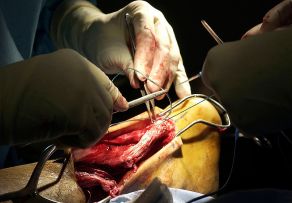Achilles Tendon Ruptures and Kobe Bryant’s Injury
April 13, 2013

Kobe Bryant, Joe Johnson Wikimedia
I woke up this morning to hear very sad news that occurred in the NBA last night: Kobe Bryant has ruptured his Achilles tendon.
Kobe, who turns 35 this year, is one of the most recognized athletes in the world (maybe one of the few things that China and the USA can agree on). He had been leading his team to crucial victories as they were making a playoff run when he succumbed to this not uncommon injury in the middle aged athlete.
As he is quoted saying, he made a move he had executed a ‘million times’ when he felt like someone had kicked him in the leg, and he subsequently crumpled to the ground. This is the classic history one might obtain when caring for an athlete with such an injury. If you watch the video, you’ll see Kobe perform a classic move which can result in a ruptured tendon: his left leg pushes back while he powerfully tries to accelerate around the defensive player; this eccentric contraction is followed by a step and immediate inability to bear weight, and he falls to the ground.
Athletes have recovered from Achilles tendon ruptures, including David Beckham, who currently plays for Paris St. Germain after rupturing his Achilles in 2010 and having subsequent surgical treatment. However, Kobe is out for the season, and the Lakers, the NBA, and the worldwide basketball community, can only hope he’ll be back next season and recover without too much diminution of his skills.
His surgery will probably take place soon, but as readers of CJSM would know, there are options for treatment that include conservative approaches. This journal has looked into the outcomes for different treatment options for Achilles tendon ruptures in the March 2012 issue: “Surgical vs. Nonsurgical Treatment of Acute Achilles Tendon Rupture,” a study authored by PR Donaldson that was part of that month’s “CJSM Sports Journal Club.” In the study, it appears that athletes opting for surgery achieve certain measures of performance (strength and endurance) earlier than those opting for non-surgical approaches, but rerupture rates (the primary outcome measure) and patient-reported function levels in the two cohorts were not statistically significantly different one year after treatment.
There were other details of the study that may inform the decision to opt for surgical treatment. The complication rate (infection, contracture, post-operative nerve injury) was 10.2%; on the other hand, one year out heel-rise remained superior in the surgically treated as opposed to the non-surgically treated patients. Unfortunately, whether treated operatively or not, “….the function of the injured leg was poorer than that of the uninjured leg after 6 and 12 months.”
Kobe will almost surely get surgery, and we can hope he’ll recover well, but in a sport which puts a premium on running, jumping, cutting and acceleration, it will bear watching to see if he can return to being the “Black Mamba” on the basketball court.
What do readers of this blog think about the options of surgical vs. non-surgical treatment of Achilles tendon ruptures? What evidence-based medical studies are in the literature that might guide this clinical decision?
